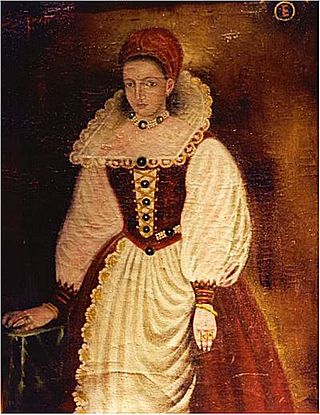
Countess Elizabeth Báthory de Ecsed was a Hungarian noblewoman and alleged serial killer from the family of Báthory, who owned land in the Kingdom of Hungary.

Karel Roden is a Czech actor, popularly known for his roles in Hellboy and The Bourne Supremacy, and his voice work in Grand Theft Auto IV.

Orava Castle is a castle situated on a high rock above Orava river in the village of Oravský Podzámok, Slovakia. It is considered to be one of the most beautiful castles in Slovakia. The castle was built in the Kingdom of Hungary, with the oldest parts being built in the thirteenth century and the most recent parts in the early seventeenth century. Many scenes of the 1922 film Nosferatu were filmed here, the castle representing Count Orlok's Transylvanian castle.

Čachtice is a village in Nové Mesto nad Váhom District in western Slovakia with a population of 4,010.

Čachtice Castle is a castle ruin in Slovakia next to the village of Čachtice. It stands on a hill featuring rare plants, and has been declared a national nature reserve for this reason. The castle was a residence and later the prison of the Countess and alleged serial killer Elizabeth Báthory.
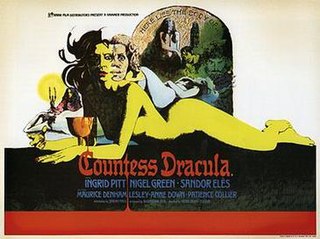
Countess Dracula is a 1971 British Hammer horror film based on some of the legends surrounding the Countess Elizabeth Báthory.

Juraj Jakubisko was a Slovak film director. He directed fifteen feature films, between 1967 and 2008. He often took on the dual role of cinematographer, and is often also credited as a screenplay writer as he usually co-writes or writes the scripts of his movies. In 2000 he was named Best Slovak Director of the 20th century by film critics and journalists. His work is often described as magical realism.

Frankenstein's Aunt is the protagonist of three novels - two by Allan Rune Pettersson and a seven-episode TV miniseries based on the first one. The story is a humorous homage to the Universal Horror Frankenstein films.
The influence of Countess Elizabeth Báthory in popular culture has been notable from the 18th century to the present day. Since her death, various myths and legends surrounding her story have preserved her as a prominent figure in folklore, literature, music, film, games and toys.

The cinema of Slovakia encompasses a range of themes and styles typical of European cinema. Yet there are a certain number of recurring themes that are visible in the majority of the important works. These include rural settings, folk traditions, and carnival. Even in the field of experimental film-making, there is frequently a celebration of nature and tradition, as for example in Dušan Hanák's Pictures of the Old World. The same applies to blockbusters like Juraj Jakubisko's A Thousand-Year Old Bee. The percentage of comedies, adventures, musicals, sci-fi films and similar genres has been low by comparison to dramas and historical films that used to include a notable subset of social commentaries on events from the decade or two preceding the film. One of them, Ján Kadár's and Elmar Klos' The Shop on Main Street, gave Slovak filmmaking its first Oscar. Children's films were a perennial genre from the 1960s through the 1980s produced mainly as low-budget films by Slovak Television Bratislava. The themes of recent films have been mostly contemporary.

The Countess is a 2009 French-German historical crime thriller drama written and directed by Julie Delpy, who also composed its score. It stars Delpy, Daniel Brühl and William Hurt. It is based on the life of the notorious Hungarian countess Elizabeth Báthory.

Burg Lockenhaus is a castle and medieval fortress in the Güns Valley in the southeastern part of Lockenhaus, in Burgenland, eastern Austria. Burg Lockenhaus is 368 metres (1,207 ft) above sea level. The castle was built in Romanesque and Gothic architectural styles around 1200, and was initially called "Leuca" or Léka. It is part of the Naturpark Geschriebenstein.
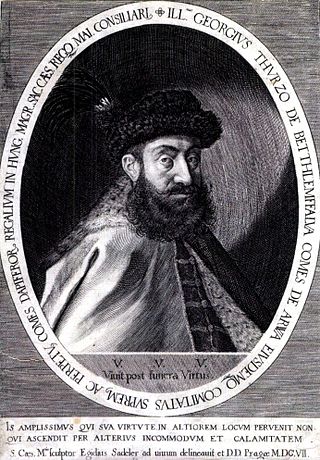
György Thurzó was a powerful Hungarian magnate, who served as the Palatine of Hungary between 1609 and 1616.
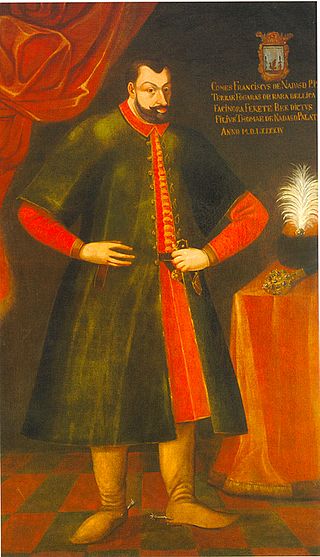
Count Ferenc II Nádasdy de Nádasd et Fogarasföld was a Hungarian nobleman. His family, Nádasdy, was one of the wealthiest and most influential of the era in Hungary. In 1571, when Ferenc was 16, his mother, Orsolya Nádasdy, using her association with many noble families in Hungary, organized a marriage to the young Elizabeth Báthory, daughter of the Count György and Anna Báthory. The Báthory family were as rich and illustrious as the Nádasdy family, though older and more influential, since they had several relatives who had the charge of Nádor (palatine) of Hungary. Among them, included a cardinal, a King of Poland-Lithuania, and a Prince of Transylvania.

Baron Zsigmond Forgách de Ghymes et Gács, sometimes Sigismund Forgách, was a Hungarian nobleman in the Kingdom of Hungary, who served as Palatine from 11 May 1618 to 23 June 1621.

Baroness Krisztina Nyáry de Bedegh was the daughter of Baron Pál Nyáry and Katalin Várday de Kisvárda. She was the second wife of Palatine Nikolaus, Count Esterházy. Her son, among others, was Paul I, Prince Esterházy.

Baroness Erzsébet Czobor de Czoborszentmihály was the second wife of Palatine György Thurzó.
The 2nd OTO Awards, honoring the best in Slovak popular culture for the year 2001, took time and place on February 2, 2002, at Reduta, a Slovak Philharmonic concert hall in Bratislava. As with the first edition of the show, the ceremony broadcast live by STV was hosted by Tibor Hlista.

Deana Jakubisková is a Slovak film producer and a former stage and film actress.
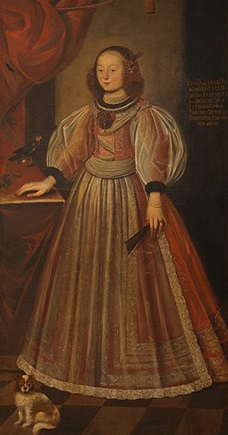
Countess Orsolya Esterházy of Galantha, was a member of the Esterházy, the only daughter of Count István Esterházy and Countess Erzsébet Thurzó, granddaughter of Nikolaus, Count Esterházy. Through her marriage to her uncle, Pál Esterházy, she became countess of Galanta.


















